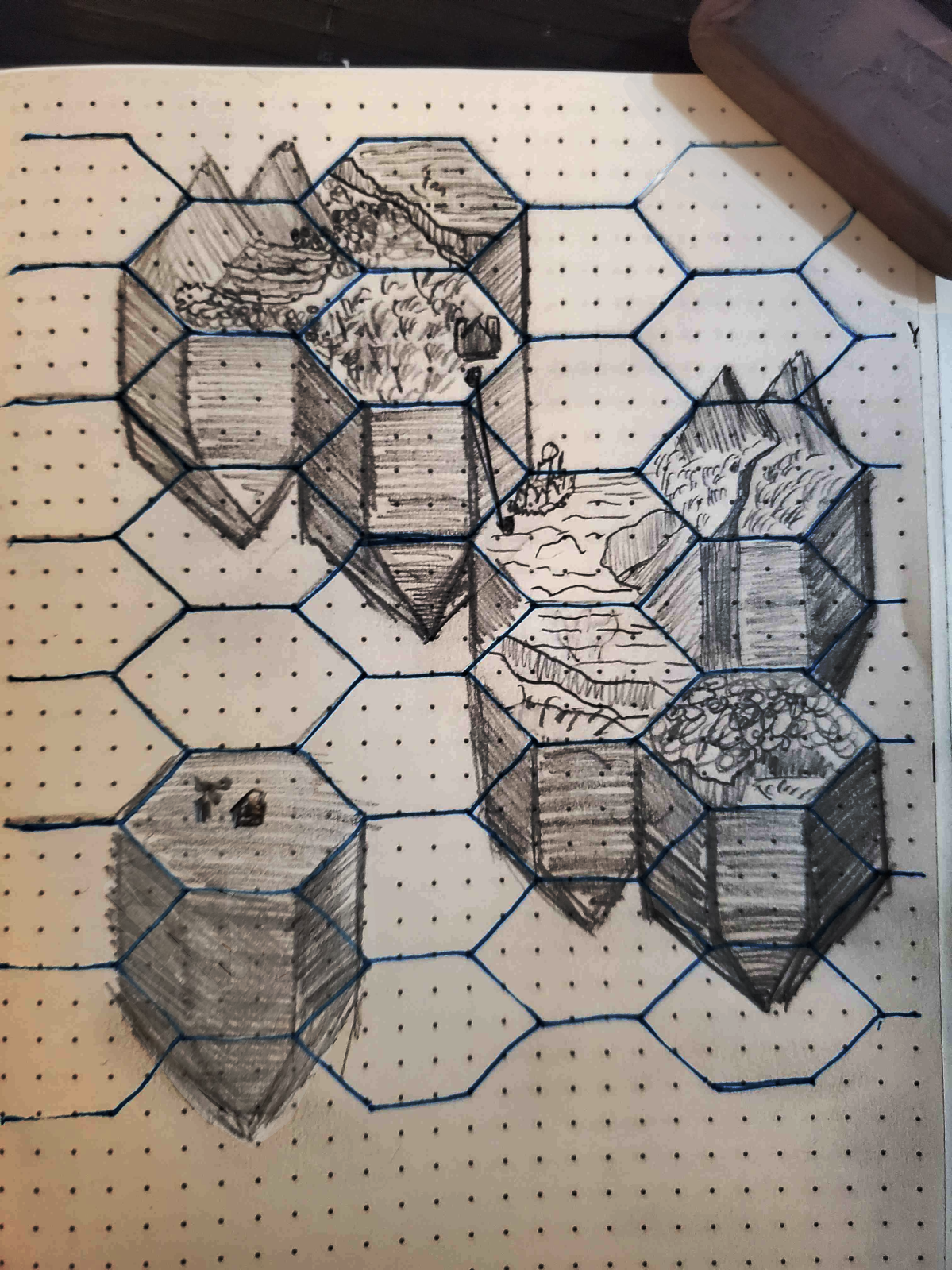Hexploration
Hexploration is a type of exploration activity where overworld sections are divided by hexes for the purposes of travel. This has created it's own subgenre within table top RPGs reaching back to the days of "Wilderness Exploration". The brother of Point of Interest Exploration, hex maps are for more methodical endeavors. Orthagonal movement is possible, and travel time is simplified for the purposes of exploration due to this sly division of the map. Perhaps unintentionally, hex (6) maps are divided into six mile wide portions provide a distance that the standard 30 foot speed adventuring party can travel across at a speed of one tile per day.
When traveling through a hex, it is possible to see major landmarks and spot points of interest within the hex. Limitations on cover and the line of sight makes it possible to miss some on the first pass, which allows multiple expeditions to find different points of interest while passing through the tile.
If given a week, and a week's worth of provisions to travel and return on an exploration expedition , how much exploration can go down before the party runs out of supplies? Baron de Ropp of Dungeon Masterpiece breaks down this level of abstraction succinctly and precisely in his discussion of hexcrawling in his video D&D HexCrawls! How To Do Exploration RIGHT! where he explains how hexcrawl should be used in a standard single fantasy world map.
For the purposes of running exploration expeditions in Nebula, a standard day's worth of travel should yield the this much ground.
It should be noted that a majority of shards can be traveled in about one day, should the exploration expedition have an preapproximation of what the general geography of the place is like. When combined into realms, these larger places can take a couple days to travel across. Traveling across a realm connector such as the Gray Path or any other established connection makes explorations a viable tenday expedition.
For the purposes of discerning the travel and logistics of each expedition please refer to the Travel in Nebula article.
Why Break Down Maps into Hexes?
Squares are incredibly messy when it comes to logistical movement. Hexes for this purpose are much cleaner. There is a blog out there at The Hydra's Grotto that really breaks down the major points as to why six mile hexes are used, math wise and also in regards to the logistics of wilderness travel. A brief reiteration of their points:- Navigation: Very clean, half day from the center- full day across 6 to 7 miles tiles on foot can equate to approximately three tiles a day.
- Horizon line limitations are matched by the hex
- Subdivision: These can be divided further into half mile divisions, this is perfect for mapping within a hex.
When traveling through a hex, it is possible to see major landmarks and spot points of interest within the hex. Limitations on cover and the line of sight makes it possible to miss some on the first pass, which allows multiple expeditions to find different points of interest while passing through the tile.
Hex Map Approximation Allows Room For Abstraction
It is because of this mathematical closeness that the hex map is used, and that it can be used as a tool. Logistics, although an interestiing aspect of warfare games and travel budgeting- absolutely slows down the pace of campaigns. With maps laid out as they are in hexes however, navigation numbers can effectively be rounded and abstracted for the easiest use in exploration expeditions.If given a week, and a week's worth of provisions to travel and return on an exploration expedition , how much exploration can go down before the party runs out of supplies? Baron de Ropp of Dungeon Masterpiece breaks down this level of abstraction succinctly and precisely in his discussion of hexcrawling in his video D&D HexCrawls! How To Do Exploration RIGHT! where he explains how hexcrawl should be used in a standard single fantasy world map.
For the purposes of running exploration expeditions in Nebula, a standard day's worth of travel should yield the this much ground.
- three flat land tiles (plains, meadows, prairies, valleys, tundras, slight hills).
- two covered tiles (forests, severe hills, deserts, snow and inclimate weather, swamp, wetlands, riverlands)
- one neigh impassable tile (mountains, canyons, cataclysmic weather, rainforest, thicket)
- four tiles that facilitate travel (roads, ferry routes, bridges, intercity tiles)
- six tiles, when you using overland flight (any normative tile on a clear day)
It should be noted that a majority of shards can be traveled in about one day, should the exploration expedition have an preapproximation of what the general geography of the place is like. When combined into realms, these larger places can take a couple days to travel across. Traveling across a realm connector such as the Gray Path or any other established connection makes explorations a viable tenday expedition.
For the purposes of discerning the travel and logistics of each expedition please refer to the Travel in Nebula article.



Comments